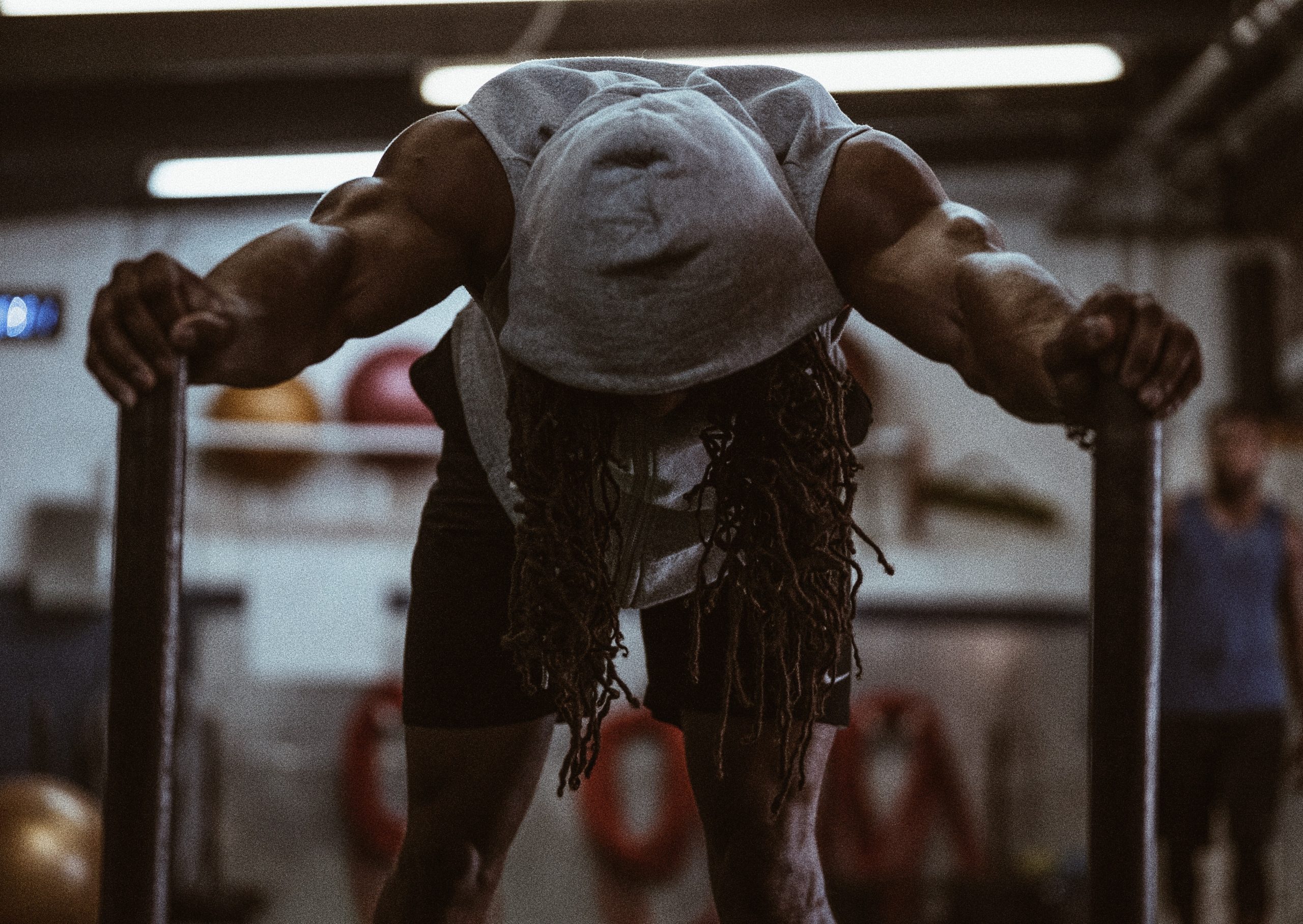
People have been comparing traditional weight training with bodyweight exercise for decades, trying to determine which one is better. But, as with most things, the worth of both exercise modalities depends on what outcomes the trainee seeks to achieve. For example, if your primary goal is to compete in powerlifting, traditional weight training will be the obvious way to go. In contrast, those looking to get in shape through equipment-free exercises would need to turn to bodyweight training.
Traditional weight training is a versatile form of exercise where folks leverage various types of resistance to induce overload, build muscle, and grow stronger (1). The most common options include barbells, dumbbells, kettlebells, gym and cable machines, and more. The sheer equipment availability makes traditional weight training incredibly nuanced and flexible because trainees can pick from countless exercises and variations. For example, you can train your chest in numerous ways, and even simple movements like the bench press come in multiple forms. Changing the incline is one unique way to adjust the bench press (2).
Bodyweight training is also versatile, though it might not seem so at first glance. The exercise modality is fantastic because trainees can use hundreds of exercises to create an effective full-body workout. Folks can also adjust the difficulty of movements to fit their current abilities. For example, you can begin with knee push-ups if that’s all you can do, but you can gradually progress to classic, decline, plyometric, and one-arm push-ups as you build strength.
Bodyweight and weighted training also come with various sub-categories that further fit trainees’ unique needs, preferences, and goals. For example, traditional weight training can refer to bodybuilding-style where folks use lighter weights for more repetitions and focus on volume accumulation, the pump, and the mind-muscle connection. But, it can also be powerlifting, where folks do the big three (squat, bench press, and deadlift) and some variations to build the most strength possible (3).
What is weight training?
As briefly discussed in the introduction, weight training has various sub-categories so that folks can pick the modality they enjoy most. Among the most popular, we have:
- Bodybuilding-style training
- Traditional gym training
- Powerlifting
- CrossFit
- Olympic weightlifting
Each of the above categories allows lifters to train their entire body through a combination of compound, assistance, and isolation movements. Some movements, including the squat and deadlift, can train up to six or more major muscles with every repetition you perform (4, 5). For example, the deadlift strengthens your entire back, shoulders, arms, midsection, quadriceps, glutes, hamstrings, and calves (5).
Traditional weight training is excellent for everyone interested in building muscle, getting stronger, becoming more functional, and improving their sports performance. Weight training is also beneficial for people looking to lose fat because the modality burns tons of calories and protects muscle from breakdown (6).
With that in mind, let’s go over nine significant benefits of traditional weight training:
- It offers trainees hundreds of practical exercises to do
- You can adjust the training loads to fit your abilities
- There are countless variations of each movement that keep your training fun and engaging.
- You can use various training styles based on your preferences and goals, including bodybuilding and powerlifting. You don’t need much equipment to get started; as little as a barbell and some weight plates can be enough.
- Weight training strengthens a range of major muscles in your body, making you stronger and more athletic.
- Lifting weights develops your core musculature, improves your balance, and reduces your risk of injuries.
- The overloading potential is fantastic, and you can keep pushing yourself to build more muscle and get stronger for many years.
- Programming isn’t that difficult to grasp, and you can start putting together effective routines within weeks of getting started.
- Weight training makes you functional and better handle everyday tasks like climbing stairs, carrying groceries, gardening, moving furniture, etc.
What is bodyweight training?
Like traditional weight training, bodyweight exercise is beneficial because of the incredible versatility and numerous training styles. A popular option is calisthenics, the art of body control and fluid motions. Home training is another option that shares similarities with calisthenics and offers unique benefits.
Aside from the great versatility, another significant benefit of bodyweight training is that you get to train and strengthen your entire body. The variety of exercises you can do will train all major muscles. Combining them can result in effective full-body workouts that build strength, muscle, and athleticism.
Folks interested in building strength, power, muscle mass, and overall athleticism would benefit significantly from bodyweight training.
So, let’s go over bodyweight training’s ten most impressive benefits:
- You need almost no equipment to train. As such, you have greater flexibility to train at home, outside, in a hotel room, or anywhere else you desire.
- Despite seeming more rigid, bodyweight training offers an extensive selection of great movements you can use to strengthen and develop all major muscles in your body.
- Aside from offering countless exercises, bodyweight training also provides numerous variations for most movements.
- It sometimes takes creativity, but you can adjust the difficulty of movements to fit your current abilities and make exercises more challenging as you progress. For example, you can start with bodyweight squats and progress to jump squats, single-leg squats, and more.
- Most bodyweight exercises recruit a large percentage of your body, improving intramuscular coordination, balance, and overall athleticism.
- Bodyweight training makes combining strength and endurance training easier to develop multiple athletic characteristics simultaneously.
- Using your body for resistance is a beginner-friendly way to get introduced to fitness and start developing your athletic base. All you have to do is begin with simple movements like knee push-ups, crunches, and bodyweight squats.
- Getting started with workouts is easier because you have no excuses. You can get a great full-body workout in so long as you have a bit of free space.
- Performing bodyweight movements is a great way to move more naturally, develop core strength and promote safety.
- Bodyweight training is cheaper than traditional weight training because you don’t need gym access to make it happen. Plus, you’ll save a few dollars on commuting.
Weight Training
Pros
- Versatile
- Great overloading potential
- Positive impact on athleticism
- Beneficial for muscle gain
- Improves intermuscular coordination
- Great for your mental health
- It can aid fat loss by promoting caloric expenditure and muscle maintenance
- You can adjust your style to focus on muscle gain, strength, or power
- Promotes health and increases your life expectancy
Cons
- Requires equipment
- Learning many of the movements takes time
- There is a risk of injury if you’re not careful and focused during workouts
- It can be challenging to keep up with your routine while traveling
Bodyweight training
Pros
- You don’t need any equipment
- It’s free because you don’t have to spend money on a gym membership or commuting
- It builds muscle and strength effectively
- Bodyweight training teaches your muscles to work together
- You can have fantastic full-body workouts in the comfort and privacy of your home
- It burns plenty of calories and supports weight loss
- It makes you functional and more athletic
- Reduces the risk of cardiovascular or metabolic disease
Cons
- It can be challenging to induce progressive overload
- More challenging movements take numerous hours of practice to learn
- You might have to do upward of 30, 40, even 50 reps to challenge yourself enough on some exercises
Is it Beneficial to do Both Forms of Training?
Trainees often develop an either-or, this-or-that, good-or-bad mentality toward unique fitness approaches. For example, if one person is an avid fan of CrossFit, they are more likely to disregard any other form of weight training. Similarly, powerlifters often believe their approach is the best and refuse to hear of different methods.
While there are benefits in being focused and avoiding the shiny object syndrome, nothing is to say that we can’t borrow elements from various training approaches to put the best possible training programs. On that thought, the question of combining traditional strength training and bodyweight exercise pops up often. People want to know if combining the two approaches would yield good results.
The answer is that, yes, mixing strength training with bodyweight exercise is a fantastic way to approach your workouts. As discussed above, both approaches offer unique benefits. For example, strength training provides a tremendous overloading potential, and bodyweight training gives you the freedom to train without equipment. Combining a few exercises from both modalities would allow you to induce high levels of mechanical tension but still have the freedom to use your body for resistance on some activities (7). If you’re training in a traditional gym, that would mean you wouldn’t have to wait for as much training equipment to have an excellent full-body workout.
Combining strength training with bodyweight exercises is an excellent way to keep your training varied, stress your muscles in numerous ways, and develop characteristics like hypertrophy, strength, agility, and stability during each full-body workout.
Weight training vs. Bodyweight training for Beginners
Weight training and bodyweight exercise are beneficial for beginners, but there are some things to consider.
Bodyweight training is the perfect start for beginners because of three reasons:
- There are plenty of beginner-friendly exercises to do. Notable examples include bodyweight squats, crunches, knee push-ups, and lunges.
- Bodyweight exercise is less intimidating than traditional strength training, and beginners find it easier to master enough activities to start exercising consistently.
- You don’t have to start going to the gym but can instead have your first workouts at home. The benefit is terrific because many beginners feel anxious to exercise in front of others and put off getting started for that very reason.
With that said, bodyweight training can still be challenging to start, especially for overweight or obese individuals. Carrying too much extra weight can make it nearly impossible to start doing even the most straightforward exercises like crunches and squats. Another issue with bodyweight training is that beginners often struggle to stay motivated and exercise consistently, even if that means doing a few sets in the living room.
Weight training is also beneficial for beginners because it offers some unique advantages. For one, beginners can start with a handful of movements, including barbell rows, back squats, the bench press, and overhead press, to grow and get stronger. Second, training at a gym can motivate beginners because they surround themselves with fit, positive, and hard-working people. Third, weight training makes it easier to adjust the resistance by manipulating the load to fit the trainee’s strength level.
Still, weight training also carries some drawbacks, including:
- Some beginners might struggle to remain consistent because of commuting to the gym, waiting around for equipment, and such
- Learning the core exercises can be difficult, and you might have to work with a personal trainer to improve your technique
- The risk of injury is slightly higher because you have to handle external weights, and you have to be extra careful
Weight Training vs. Bodyweight Training for Athletes
Bodyweight training is excellent for many athletes because the modality is more accessible, less mentally demanding, and beneficial for numerous athletic characteristics. For example, athletes interested in strength-endurance can perform longer sets and more reps and less recovery in-between (8). In contrast, those interested in developing strength, speed, and agility can perform more dynamic movements, such as jump squats and plyometric push-ups (9).
Aside from the above benefits, bodyweight training is excellent for athletes because they can leverage the modality easily and have full-body workouts at home.
With that said, bodyweight training does carry some drawbacks, the main of which is that athletes might struggle to keep pushing themselves to improve. Often, the best way to keep pushing yourself is to do extra reps, but that can make the training boring and cause unnecessary fatigue that prolongs the recovery period.
Weight training is also beneficial, and countless athletes perform exercises like the barbell squat, bench press, and deadlift to elevate their performance. Similar to bodyweight movements, traditional weight training offers flexibility and allows you to focus on various characteristics, including strength-endurance and raw power. Lifting weights also develops the core musculature and improves athletes’ stability and balance. As a result, they can stay safe and perform better.
Still, weight training can be dangerous for athletes. One of the primary risks is overtraining because athletes often have demanding programs to follow. Too much weight training can lead to recovery issues and stall their progress (10).
Full-Body Workout (Weight Training)
Exercise 1: Barbell back squat – 4 sets of 6 to 10 reps (The movement strengthens your quadriceps, glutes, midsection, back, and shoulders.)
Exercise 2: Flat barbell bench press – 3 sets of 8 to 10 reps (The bench press develops your chest, shoulders, and triceps.)
Exercise 3: Bent-over dumbbell row – 3 sets of 8 to 12 reps (The exercise develops your back, midsection, and biceps.)
Exercise 4: Glute-ham raises – 3 sets of 8 to 15 reps (The exercise is fantastic for developing your glutes, hamstrings, and lower back.)
Click here for more full-body workouts
Full-Body Workout (Bodyweight)
Exercise 1: Chin-ups – 3 sets of 5 to 10 reps (Chin-ups are great for your core, back, and bicep strength.)
Exercise 2: Single-leg squat – 3 sets of 5 to 15 reps (Single-leg squats are great for fixing muscle imbalances and developing your quadriceps.)
Exercise 3: Single-leg Romanian deadlift – 3 sets of 15 to 30 reps (A great movement that fixes muscle imbalances and strengthens your hamstrings, glutes, and lower back.)
Exercise 4: Decline push-ups – 3 sets of 5 to 20 reps (A more challenging push-up variation that trains your shoulders, triceps, and upper chest.)
Click here for more full-body bodyweight workouts
Conclusion
People have compared bodyweight and weight training for a long time, and they will continue to do so in the future. Both modalities offer their unique benefits, and you can leverage either of the two to improve your athleticism, build muscle, and get stronger.
For example, one person might love barbell training, so it wouldn’t make sense to tell them, “Do push-ups instead. They are much better.” Similarly, some folks prefer bodyweight training because of its flexibility and functionality. As such, they can perform movements like squats, push-ups, and pull-ups for an effective full-body workout.
Weight and bodyweight training also carry some unique drawbacks, which we have to consider. For instance, lifting weights requires equipment, and your best option is to visit a gym. Doing so means you have to commute, spend money on a membership, wait around for equipment, deal with restrictions, and more. On the other hand, bodyweight training doesn’t have these drawbacks, but you might struggle to induce overload to keep progressing.
What matters most is that you pick the modality that fits your goals, preferences, and available equipment.
About the author : Daniels




